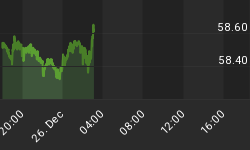Originally published April 26th, 2009.
Last week gold rallied away from the danger zone, leaving behind a fine small Double bottom on its chart, and it is now shaping up to begin a strong run.
On the 6-month chart we can see that gold honored the support described as being of key importance in the last update, rallying away from its early April low and its 200-day moving average to approach the return line of the downtrend channel shown. This is positive action that has created a cushion for those long gold. Although it has yet to break out from the downtrend, the completion of the Double Bottom and the bullish MACD cross through its moving average shown at the bottom of the chart is a clear sign that such a breakout is probably pending. Gold is now somewhat overbought after its gains of last week, so it is quite likely that it will back off from the upper red trendline before breaking out, although there is no guarantee of this. Once it does break out, a rapid advance to challenge the highs is to be expected. Note that the intraday spike down on Friday did not occur - it is a data error. Possible tactics for would-be buyers include buying on a pullback from the red return line, or waiting for the breakout and then buying on a pullback towards the trendline, should one occur.

The US dollar did break out above the resistance at 86 on its index, as predicted in the last update. However, the resulting gains proved to be of less magnitude and duration than we had expected, with an ugly sharp reversal quickly setting in. This reversal has brought it back to the support line of the uptrend channel in force from last July for the 3rd time in recent weeks, and has thus greatly increased the risk of an imminent breakdown. While the steadily rising 200-day moving average beneath the index would ordinarily be construed as a bullish influnce that would lead to another rally, this must be weighed against the strongly bearish Rising Wedge evident on the chart, with last week's reversal suggesting that it will not now make a final rally at the upper return line of the converging channel before it breaks lower. Furthermore the pattern of recent weeks may well be a countertrend bear Flag, which would be logical given the severity of the mid-March plunge, that has long-term bearish implications, and if that is what it is then another plunge may be imminent, that could be worse than the one in mid-March, on account of it involving failure of the major uptrend. Given that the entire uptrend from last July was a ramp caused by a terror-stricken flight into Treasuries, it is quite clear that it could go down even faster than it went up should the uptrend fail, and the decay of recent months is made ominously clear by the succession of lower highs being made by the MACD indicator shown at the bottom of the chart.

If the dollar plunges then it of course implies that the market for Treasuries is souring, which is understandable when you stop to think about the recent confidence-inspiring move by the Fed, when it announced that it would be monetizing Treasuries, i.e. propping the market up by creating money to buy them. This being so we should be able to see evidence of increasing weakness on the Treasury charts, and sure enough you can.

On the 6-month chart for the 30-year Treasury bond we can see that it has been subjecting a major support level to what may be described as a "stress test" in recent days, and it is now very close to breaking down, as is the dollar as we have just observed. The results of this test are likely to be known very soon, and given that the dollar went up largely because of a tidal wave of funk money panicking into Treasuries, it seems logical to suppose that a strong flow in the opposite direction is likely to involve a concomitant plunge in both the dollar and Treasuries. Thus, it will be interesting to see if the PPT, who are doubtless racking up overtime this weekend, can hold the line for a bit longer. Should we see a combined breakdown by both the dollar and Treasuries soon, we could see an extraordinarily powerful rally in gold and silver that quickly takes gold to new highs and would result in potentially spectacular gains in Precious Metals stocks. In this scenario interest rates would rocket and the nascent "recovery" in the US economy being so widely touted at the current time on major US TV networks would quickly be consigned to the trash can.















